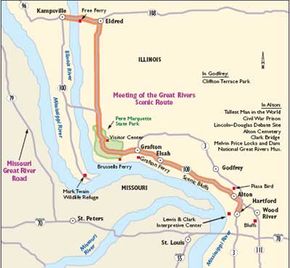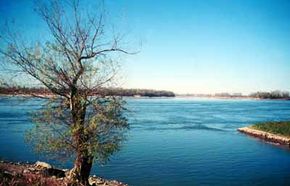Within the expanse of Great Rivers Scenic Route, the Mississippi, Missouri, and Illinois Rivers meet to form a 35,000-acre floodplain. This confluence is the backdrop for the Meeting of the Great Rivers Scenic Route. The river systems have been vital transportation routes as long as there has been human habitation, moving people and goods to world markets.
The Meeting of the Great Rivers Scenic Route offers a dramatic composite of the Mississippi River. Beneath white cliffs, the byway runs next to the Mississippi, beginning in an industrial, urban setting and changing to a scenic, natural area. As though moving back through time, expanses of pastoral countryside and stone houses are reminders of a time long ago. Artifacts of the earliest aboriginal people in America reside here, and the byway's rich historical and archaeological qualities unfold. Little towns along the byway seem almost forgotten by time, giving travelers a look at historic architecture and small-town life along the Mississippi River.
Advertisement
Archaeological Qualities of Great Rivers Scenic Route
Despite present-day development, archaeological remains are largely intact along the Meeting of the Great Rivers Scenic Route. For example, the Koster Site, located south of Eldred, is world renowned because of the evidence found that shows that humans lived on the site 8,000 years ago. Structures dating back to 4200 B.C. are considered to be the oldest such habitations found in North America, and villages flourished here circa 6000 B.C., 5000 B.C., and 3300 B.C. More than 800 archaeological sites have been inventoried along the route. Experts believe that the Mississippi and Illinois Rivers, known as the Nile of North America, nourished the development of complex and sophisticated Native American cultures. So complete are cultural records that archaeologists term the area "the crossroads of prehistoric America."
Cultural Qualities of Great Rivers Scenic Route
Visitors discover real river towns along this byway. To celebrate each unique aspect of their culture, many of the communities on the byway have established their own museums. In addition, the region displays an appreciation of high culture through orchestras, theaters, galleries, institutions of higher learning, and many diverse festivals that celebrate the arts. Throughout the year, more than 50 festivals and fairs celebrate the history, art, music, and crafts of this region.
Qualities of Great Rivers Scenic Route
The Mississippi River is internationally famous. Father Jacques Marquette and Louis Jolliet first made their expedition down the Mississippi in 1673. Later, when the Illinois Territory was formed, the Missouri River was the gateway to the unexplored West, and the Illinois River led to the Great Lakes and was also a connection to the East. Early American explorers began in the confluence area. Lewis and Clark, for example, embarked from Fort Dubois near the mouth of the Missouri. Eventually, towns were settled on the shores of the rivers, providing a secure way for travel and commerce using the rivers. The buildings that composed these towns still stand, many of them dating to the early 1800s.
As the nation grew and developed, many of the towns along the byway were growing and developing as well. Although many of the towns that stand today seem to be nestled somewhere in history, some of the byway's communities have been at the edge of new ideas. During pre-Civil War times, the Underground Railroad ran through this area, bringing escaped slaves to the safety of the north. Confederate prison ruins found on the byway are another testament to this corner of Illinois' involvement in the Civil War. By the late 19th century, Mark Twain's Mississippi River stories had inspired an ideal of Mississippi legends, history, and culture in the minds of Americans. Meanwhile, as the river and its uses were also evolving, paddleboats gave way to barges and tows.
River traffic increased as industries grew, and Lock and Dam 26 was built. Today, historic 18th-century river towns, islands, bars, points, and bends create beautiful scenery beneath limestone bluffs, which are covered by forests that extend nearly 20,000 acres. Historical and cultural features in the 50-mile corridor have received national recognition, with seven sites presently registered on the National Register of Historic Places.
Qualities of Great Rivers Scenic Route
Nature abounds along the Meeting of the Great Rivers Scenic Route. The wetlands from three different waterways, the rock bluffs, and the stately trees all harbor native creatures and provide lovely views along the byway. The palisade cliffs and towering bluffs provide a characteristic drive along the riverside where visitors can see the results of this great channel of water carving its way through post-glacial terrain. You may want to enjoy the nature of the byway from the car, look for hikes along the way, or get out and explore a wildlife refuge.
Located right in the middle of the United States is Piasa country, a bird-watcher's heaven. Migratory flyways using the Mississippi, Illinois, and Missouri Rivers converge within a 25-mile zone from Alton to Grafton. This offers amazing opportunities to see many species of birds that pass through this chokepoint region, from the American bald eagle to the white pelican. Deer, otters, and beavers are present, as well as raccoons, opossums, and squirrels. Fishing enthusiasts will discover many species in the local waters.
Many natural points of interest dot this byway. For example, Pere Marquette State Park is one of Illinois' largest state parks. It is nestled along the banks of the Illinois River on the byway near Grafton. Here, a myriad of trails take you within the wild forests and up to spectacular viewing areas along the bluff line above.
The Riverlands Environmental Demonstration Area is another natural point of interest. Located near Alton, this U.S. Army Corps of Engineers site provides a fertile wetland that attracts all types of wildlife. Early-morning travelers frequently see wildlife making their way to the river. The Mark Twain Wildlife Refuge is located near Pere Marquette State Park and is often open to the public. The preserve offers sanctuary to rare and endangered migratory birds on their long flights up and down the Mississippi and Illinois Rivers.
All the stunning views that can be enjoyed from a vehicle can also be enjoyed on foot or by bike. The Sam Vadalabene Trail, a bicycle and walking trail, winds more than 25 miles from Alton to Pere Marquette State Park on the byway, making this a byway that encourages and accommodates hikers and bikers.
Qualities of Great Rivers Scenic Route
After you have seen the sights on the Meeting of the Great Rivers Scenic Route, you may decide to enjoy the surroundings on a closer level. Trails and paths along the byway offer excitement for hikers and bikers. Also, forests that line the roadsides are perfect places for camping, picnicking, or simply enjoying the peaceful solitude that nature affords. Be sure to tour the historic districts of the byway communities and stop at the museums and visitor centers that provide a closer look at the byway and its characteristics.
There is always fun to be found on the Mississippi River. Visitors enjoy the water in every way, from parasailing to jet skiing. Sailboats and riverboats keep the river alive with movement year-round. During the summer, families stop at one of the two water parks along the byway or travel on one of the four free river ferries located in the area. The Meeting of the Great Rivers Scenic Route is one of the most accommodating to bikers, with a bicycle path that goes directly along the byway.
Shopping for crafts and antiques in the historic riverside towns along the byway is a pleasant pastime, and golfers enjoy the ten courses in the region. There's a theater in Wood River and an amphitheater in Grafton for musical productions, stage productions, and other kinds of entertainment. It is hard to miss the Alton Belle Riverboat Casino on a leisurely cruise down the river. In addition to the attractions along the byway, festivals, fairs, and events are always occurring in its communities.
Find more useful information related to Illinois' Great Rivers Scenic Route:
- Illinois Scenic Drives: Glenn Highway is just one of the scenic byways in Illinois. Check out the others.
- How to Drive Economically: Fuel economy is a major concern when you're on a driving trip. Learn how to get better gas mileage.
Advertisement

